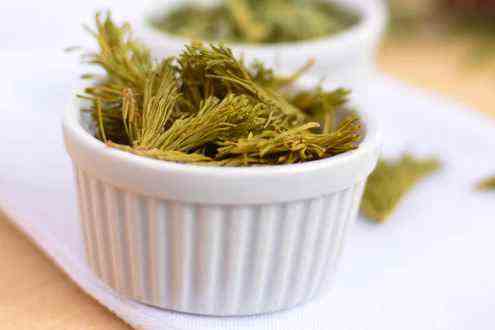Young plants
Preferably harvested in the spring, then dried, young balsam fir shoots can be eaten in various ways. To the taste, there is no bitterness, but rather a sweet side, fruity in particular – some speak of notes of raspberries and cherries – even a candy flavor. Its needles can be infused into herbal tea, its smell of fresh fir will inevitably evoke the holiday season. The fir tree is also attributed medicinal properties for the treatment of coughs and colds, in particular. Powdered or crushed, the sprouts can enhance many desserts, poultry or fish dishes, vinaigrettes or even be used as a finish on a beef tartare. A few Quebec companies, including Pilki, Gourmet Sauvage, Épices de Cru and even the Abbaye Val Notre-Dame, market balsam fir shoots, in one form or another. Épices de Cru also suggests a balsam fir and lemon yule log recipe on its website.
Estrie fir honey

PHOTO FROM JÉRÉMIE POSTEL’S WEBSITE
Fir honey, Jérémie Postel, $13.50 for 135 g or $21.50 for 330 g
French by origin, established in Quebec since 2011, Jérémie Postel quickly fell in love with the mountain of Sutton. For the past few years, the man who has made it his mission to raise awareness of the heritage value of our forests has been traveling through the valleys of Sutton to harvest balsam fir shoots which he then macerates in honey from the Api farm. in Mansonville. Some use it as a cough remedy or simply to enhance a dish. On her website, chef Chloé Ostiguy, of the restaurant L’Archipel, offers a fine selection of winter recipes embellished with balsam fir. In addition to honey, Jérémie Postel also offers jellies and jams that combine fruit and balsam fir, as well as a kombucha.
The drinking tree

PHOTO FROM THE SAQ WEBSITE
Gin KM12, Distillerie du Fjord, $47 for 750ml
In terms of enhancing boreal flavors, the reputation of the Distillerie du Fjord and its KM12 gin is well established, although other Quebec distillers also incorporate conifers into their elixir. Let’s think of the Distillerie Fils du Roy and its Thuya gin with cedar or Wabasso and its Conifère gin with spruce (it’s not fir!). Developed near the Monts Valin in Saguenay, KM12 is made from several ingredients harvested from the surrounding boreal forest, including balsam fir shoots that give it a woody aroma. We should also mention Opémiska gin, launched by the Cherry River distillery in collaboration with 2Frères, which also includes fir in its recipe.
A sweet touch

PHOTO FROM THE GOURMET SAUVAGE WEBSITE
Fir syrup, Gourmet Sauvage, $15 for 245 ml
Not a gin lover, but want to incorporate the tree into your cocktails? Gourmet Sauvage offers, in small quantities, a syrup made from fresh, hand-picked wild fir needles, cane sugar and a touch of acidity. It can be enjoyed on ice cream, pastries, fish or even in a mojito, as suggested by the company, which also organizes popular harvesting workshops in the Laurentian forest.
For those who prefer salty

PHOTO FROM THE SALAISON DU BISTRO D WEBSITE
Sausage with Beemer gin and fir essential oil, Salaison du Bistro D, $9 for 95 g
Back in Saguenay, La Salaison du Bistro D has been marketing, since last January, a sausage with regional flavors cooked by artisan charcutier David Rousseau using gin from the Jeannois distillery Beemer and balsam fir essential oil. The distribution of Monsieur D charcuterie is limited for now. They can be found in about thirty points of sale in Saguenay–Lac-Saint-Jean and soon in the Quebec region.
